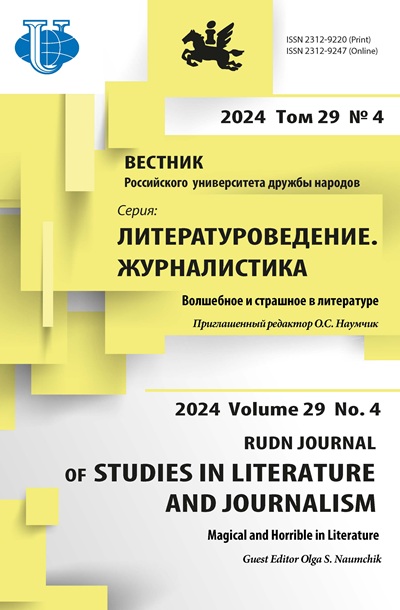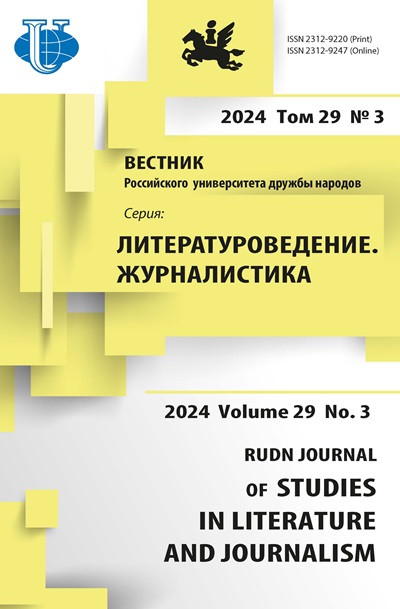Environmental agenda setting in local media: Thematic and attributive levels
- Authors: Lobodenko L.K.1, Cherednyakova A.B.1, Kornilova L.N.1, Marfitsina A.R.1
-
Affiliations:
- South Ural State University
- Issue: Vol 29, No 3 (2024)
- Pages: 577-592
- Section: JOURNALISM
- URL: https://journals.rudn.ru/literary-criticism/article/view/41918
- DOI: https://doi.org/10.22363/2312-9220-2024-29-3-577-592
- EDN: https://elibrary.ru/GFGHBY
Cite item
Full Text
Abstract
The article presents the results of analysis of information agenda of regional media and social media on ecology. The theoretical coordinates of the study are set by the theory of “agenda formation” at two levels - thematic and attributive. The authors’ goal is to identify the problems of the information agenda of the regional media and social media on ecology, categorize its attributes, as well as an eye tracking analysis of the attention of the youth audience to the identified categories of attributes. The research materials were media texts of 13 online media and 6 urban online communities of the VKontakte network (for 2022) of six industrial cities of the Chelyabinsk region. For the first time, the results of a theoretical and empirical study of the topic from the standpoint of a cognitive-matrix analysis of categories and attributes of the information agenda, the use of eye tracking technologies in studying the reaction of the youth audience are presented. The results obtained made it possible to identify 10 categories of attributes of the information agenda on ecology. As the study showed, the attributes of the category “environmental problems” are most often presented in quantitative linguistic expression in media texts.
About the authors
Lidia K. Lobodenko
South Ural State University
Author for correspondence.
Email: lobodenkolk@susu.ru
ORCID iD: 0000-0002-0809-1686
Doctor of Philology, Professor at the Department of Journalism, Advertising and Public Relations
76 Lenina Prospect, Chelyabinsk, 454080, Russian FederationAnna B. Cherednyakova
South Ural State University
Email: cheredniakovaab@susu.ru
ORCID iD: 0000-0002-5681-8800
Doctor of Pedagogy, Professor at the Department of Journalism, Advertising and Public Relations
76 Lenina Prospect, Chelyabinsk, 454080, Russian FederationLarisa N. Kornilova
South Ural State University
Email: kornilovaln@susu.ru
ORCID iD: 0000-0002-0316-5965
Candidate of Philology, Associate Professor of the Department of Russian Language and Literature, Institute of Media, Social Sciences and Humanities,
76 Lenina Prospect, Chelyabinsk, 454080, Russian FederationArina R. Marfitsina
South Ural State University
Email: marfitcynaar@susu.ru
ORCID iD: 0000-0002-7174-1442
Candidate of Philology, Associate Professor at the Department of Journalism, Advertising and Public Relations, Institute of Media, Social Sciences and Humanities
76 Lenina Prospect, Chelyabinsk, 454080, Russian FederationReferences
- Algavi, L.O., Volkova, I.I., Kadyrova, Sh.N., & Rastorgueva, N.E. (2021). Youth literary networks as a key to understanding generation Z. Bulletin of Moscow University (Series 10. Journalism), 3, 3–21. (In Russ.) https://doi.org/ 10.30547/vestnik.journ.3.2021.321
- Alkazemi, M.F., & Wanta, W. (2018). The effect of oil prices on the media agenda: A model of agenda building. Newspaper Research Journal, 39(2), 232–244. https://doi.org/10.1177/0739532918775655
- Boldyrev, N.N. (2009). Conceptual basis of language. In: Kubryakova E.S. (ed.) Cognitive studies of language. Vol. 4: Conceptualization of the world in language. Tambov: Derzhavin Tambov State University Publ. House. P. 25–78. (In Russ.)
- Dunas, D.V., & Vartanov, S.A. (2020). Youth as media audience: theoretical approaches in Russian media studies. Theoretical and Practical Issues of Journalism, 9(1), 106–122. (In Russ.) https://doi.org/10.17150/2308-6203.2020.9(1).106-122
- Geiß, S. (2022). A matter of perspective? The impact of analysis configurations on testing the agenda-setting hypothesis. Media and Communication, 10(3), 118–132. https://doi.org/10.17645/mac.v10i3.5375
- Golan, G., & Wanta, W. (2001). Second-level agenda setting in the New Hampshire primary: A comparison of coverage in three newspapers and public perceptions of candidates. Journalism and Mass Communication Quarterly, 78, 247–259.
- Hao, X. (2022). Analysis of the characteristics of agenda setting theory in the new media era. Journal of Humanities and Social Sciences Studies, 4(3), 213–216. https://doi.org/10.32996/jhsss.2022.4.3.21
- Kaminchenko, D.I. (2019). Comparative analysis of the information agenda of the mass media and modern social media. Mediascope, 4. (In Russ.) https://doi.org/10.30547/mediascope.4.2019.3
- Kaminchenko, D.I. (2020). Interaction of mass media and society: agenda analysis. Issues in Journalism, Education, Linguistics, 39(4), 533–544. (In Russ.) https://doi.org/10.18413/2712-7451-2020-39-4-533-544
- Kim, S.-H., Han, M., Choi, D.-H., & Kim, J.-N. (2012). Attribute agenda setting, priming and the media’s influence on how to think about a controversial issue. International Communication Gazette, 74(1), 43–59. https://doi.org/10.1177/1748048511426991
- King, P. (1997). The press, candidate images, and voter perceptions. In: McCombs M.E., Shaw D.L., Weaver D.H. (eds.) Communication and Democracy: Exploring the intellectual frontiers in agenda-setting theory. New York: Routledge. P. 29–40.
- Kosicki, G. (1993). Problems and opportunities in agenda-setting research. Journal of Communication, 43(2), 100–127. https://doi.org/10.1111/j.1460-2466.1993.tb01265.x
- Lobodenko, L., Shesterkina, L., Cheredniakova, A., Perevozova, O., & Kharitonova, O. (2022). Perception of environmental information materials by youth audiences: Results of a neuromarketing study. World of Media. Journal of Russian Media and Journalism Studies, 3, 5–44. https://doi. org/10.30547/worldofmedia.3.2022.1
- Mamonov, M.V. (2008). The role of political actors in shaping the priorities of the interpersonal “agenda” of Russians. Political expertise: POLITEX, 4(3), 97–105. (In Russ.)
- McCombs, M., & Evatt, D. (1995). Los temas y los aspectos: Explorando una nueva dimension de la agenda setting. Comunicacion y Sociedad, 8(1). P. 7–32.
- McCombs, M.E., & Shaw, D.L. (1972). The agenda-setting function of the mass media. Public Opinion Quarterly, 36(2), 176–187. https://doi.org/10.1086/267990
- Media generations of digital civilization: mediachronotop, archetypes and value dominants. (2020). In: Shesterkina L.P., Lobodenko L.K. (eds.) Media communications and internet marketing in the conditions of the digital civilization. Chelyabinsk: South Ural State University. P. 55–80. (In Russ.)
- Minooie, M., Taylor, J., & Vargo, C.J. (2023). Agendamelding and COVID-19: the dance of horizontal and vertical media in a pandemic. Frontiers in Political Science, 5. https://doi.org/10.3389/fpos.2023.1021855
- Östman, J. (2014). The influence of media use on environmental engagement: A political socialization approach. Environmental Communication, 8(1), 92–109. https://doi.org/10.1080/17524032.2013.846271
- Rodríguez-Díaz, R., & McCombs, M. (2023). Personal agenda-public agenda congruency: A contingent condition for agenda-setting effects. Communication & Society, 36(4), 191–212. https://doi.org/10.15581/003.36.4.191-212
- Rogers, E.M., & Dearing, J.W. (1988). Agenda-setting research: Where has it been, where is it going? Annals of the International Communication Association, 11 (Issue 1: Communication Yearbook 11), 555–594. https://doi.org/10.1080/23808985.1988.11678708
- Scheufele, D.A. (2000). Agenda-setting, priming, and framing revisited: Another look at cognitive effects of political communication. Mass Communication and Society, 3(2), 297–316. https://doi.org/10.1207/S15327825MCS0323_07
- Son, Y.J., & Weaver, D.H. (2005). Another look at what moves public opinion: Media agenda setting and polls in the 2000 U.S. election. International Journal of Public Opinion Research, 18(2), 174–197. https://doi.org/10.1093/ijpor/edh090
- Su, Y., & Xiao, X. (2024). Intermedia attribute agenda setting between the U.S. mainstream newspapers and Twitter: A two-study analysis of the paradigm and driving forces of the agenda flow. Journalism & Mass Communication Quarterly, 101(2), 451–476. https://doi.org/10.1177/10776990231221150
- Vazhenina, I.S. (2006). Image and reputation of the territory as a basis for promotion in a competitive environment. Marketing in Russia and abroad, 6, 49–57. (In Russ.)
- Volkova, I.I., & Lazutova, N.M. (2013). Ethical and playful in the attitudes of communicators of different generations. European Journal of Social Sciences, 11-1(38), 285–290. (In Russ.)
- Weaver, D.H. (2007). Thoughts on agenda setting, framing, and priming. Journal of Communication, 57(1), 142–147. https://doi.org/10.1111/j.1460-2466.2006.00333.x
- Yousaf, M., Hu, Z., & Raza, S.H. (2023). News media exposure and community consensus on terrorism in a developing country: First and second level agenda-setting effects. Media Watch, 14(1), 33–57. https://doi.org/10.1177/09760911221130818
Supplementary files


















